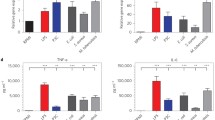Abstract
Monocytes display a gradual change in metabolism during inflammation. When activated, the increase in glucose utilization is important for monocytes to participate in immune and inflammatory responses. Further studies on the mechanism underlying this biological phenomenon may provide a new understanding of the relationship between immune response and metabolism. The THP-1 cells were used as a monocyte model. The cells were activated with lipopolysaccharide (LPS). Glucose uptake was measured using flow cytometry. The expression of fibroblast growth factor 21 (FGF-21), glucose transporter 1 (GLUT-1), and other FGF-21 signaling pathway-related factor mRNAs was determined by real-time polymerase chain reaction. Further, the relationship between FGF-21 expression in monocytes and phosphatidylinositol-3-kinase (PI3K)-protein kinase B (Akt) signaling pathway was determined by Western blotting. LPS elevated FGF-21 expression in monocytic THP-1 cells in vitro. Functional assays showed that the phenomenon in which LPS and FGF-21 stimulated glucose uptake in monocytic THP-1 cells could be inhibited by FGFR inhibitor. The mechanism of elevation of FGF-21 was found to involve the PI3K/Akt signaling pathway. This study indicated that FGF-21 could regulate the immune response indirectly by influencing the glucose uptake of activated monocytes cells.





Similar content being viewed by others
References
Palmer, C.S., J.J. Anzinger, Z. Jingling, et al. 2014. Glucose transporter 1-expressing proinflammatory monocytes are elevated in combination antiretroviral therapy-treated and untreated HIV+ subjects. The Journal of Immunology 193 (11): 5595–5603.
Calder, P., G. Dimitriadis, and P. Newsholme. 2007. Glucose metabolism in lymphoid and inflammatory cells and tissues. Current Opinion in Clinical Nutrition & Metabolic Care 10 (4): 531–540.
Calder, P.C. 1995. Fuel utilization by cells of the immune system. Proceedings of the Nutrition Society 54 (1): 65–82.
Maratou, E., G. Dimitriadis, A. Kollias, et al. 2007. Glucose transporter expression on the plasma membrane of resting and activated white blood cells. European Journal of Clinical Investigation 37 (4): 282–290.
Palsson-Mcdermott, E.M., and L.A.J. O'Neill. 2013. The Warburg effect then and now: from cancer to inflammatory diseases. Bioessays News & Reviews in Molecular Cellular & Developmental Biology 35 (11): 965–973.
Fu, Y., L. Maianu, B.R. Melbert, and W.T. Garvey. 2004. Facilitative glucose transporter gene expression in human lymphocytes, monocytes, and macrophages: a role for glut isoforms 1, 3, and 5 in the immune response and foam cell formation. Blood Cells Molecules & Diseases 32 (1): 182–190.
Zhang, J., and Y. Li. 2014. Fibroblast growth factor 21, the endocrine FGF pathway and novel treatments for metabolic syndrome. Drug Discovery Today 5 (19): 579–589.
Kharitonenkov, A., T.L. Shiyanova, A. Koester, A.M. Ford, R. Micanovic, E.J. Galbreath, G.E. Sandusky, L.J. Hammond, J.S. Moyers, R.A. Owens, et al. 2005. FGF-21 as a novel metabolic regulator. The Journal of Clinical Investigation 115 (6): 1627–1635.
Wang, W.F., L. Ma, M.Y. Liu, et al. 2015. A novel function for fibroblast growth factor 21: stimulation of NADPH oxidase-dependent ROS generation. Endocrine 49 (2): 1–11.
Feingold, Kenneth R., Carl Grunfeld, Josef G. Heuer, Akanksha Gupta, Martin Cramer, Tonghai Zhang, et al. 2012. FGF21 is increased by inflammatory stimuli and protects leptin-deficient ob/ob mice from the toxicity of sepsis. Endocrinology 153 (6): 2689–2700.
Izumiya, Y., H.A. Bina, N. Ouchi, Y. Akasaki, A. Kharitonenkov, and K. Walsh. 2008. FGF21 is an Akt-regulated myokine. FEBS Letters 582 (27): 3805–3810.
Tanimura, Y., W. Aoi, Y. Takanami, et al. 2016. Acute exercise increases fibroblast growth factor 21 in metabolic organs and circulation. Physiological Reports 4 (12): e12828.
Arkan, M.C., A.L. Hevener, F.R. Greten, et al. 2005. IKK-β links inflammation to obesity-induced insulin resistance. Nature Medicine 11 (2): 191–198.
Lee, J.S., W.M. Nauseef, A. Moeenrezakhanlou, L.M. Sly, S. Noubir, K.G. Leidal, J.M. Schlomann, G. Krystal, and N.E. Reiner. 2007. Monocyte p110α phosphatidylinositol 3-kinase regulates phagocytosis, the phagocyte oxidase, and cytokine production. Journal of Leukocyte Biology 81: 1548–1561.
Guha, M., and N. Mackman. 2002. The phosphatidylinositol 3-kinase-Akt pathway limits lipopolysaccharide activation of signaling pathways and expression of inflammatory mediators in human monocytic cells. The Journal of Biological Chemistry 277: 32124–32132.
Izumiya, Y., H.A. Bina, N. Ouchi, et al. 2008. FGF21 is an Akt-regulated myokine. FEBS Letters 582 (27): 3805–3810.
Lund, M.E., J. To, B.A. O'Brien, et al. 2016. The choice of phorbol 12-myristate 13-acetate differentiation protocol influences the response of THP-1 macrophages to a pro-inflammatory stimulus. Journal of Immunological Methods 430: 64–70.
Auwerx, J. 1991. The human leukemia cell line, THP-1: a multifacetted model for the study of monocyte-macrophage differentiation. Experientia 47 (1): 22–31.
Millet, P., V. Vachharajani, L. McPhail, et al. 2016. GAPDH binding to TNF-α mRNA contributes to posttranscriptional repression in monocytes: a novel mechanism of communication between inflammation and metabolism. The Journal of Immunology 196 (6): 2541–2551.
Author information
Authors and Affiliations
Corresponding author
Electronic supplementary material
ESM 1
(DOCX 98 kb)
Rights and permissions
About this article
Cite this article
Wang, N., Li, JY., Zhao, Tt. et al. FGF-21 Plays a Crucial Role in the Glucose Uptake of Activated Monocytes. Inflammation 41, 73–80 (2018). https://doi.org/10.1007/s10753-017-0665-7
Published:
Issue Date:
DOI: https://doi.org/10.1007/s10753-017-0665-7




